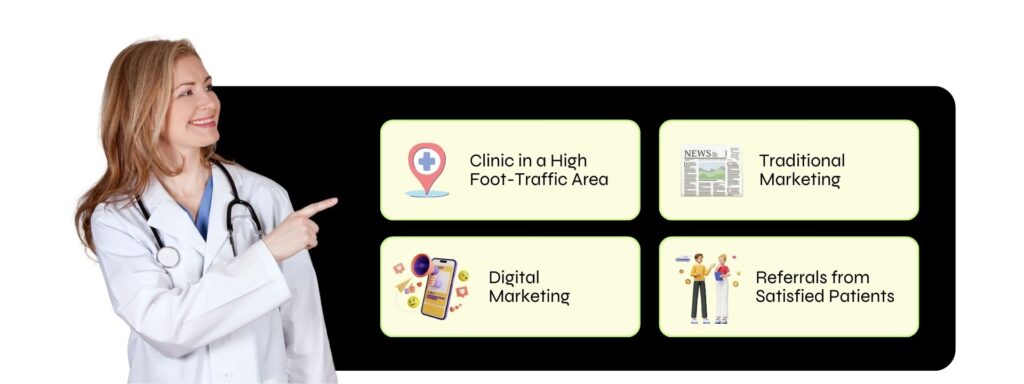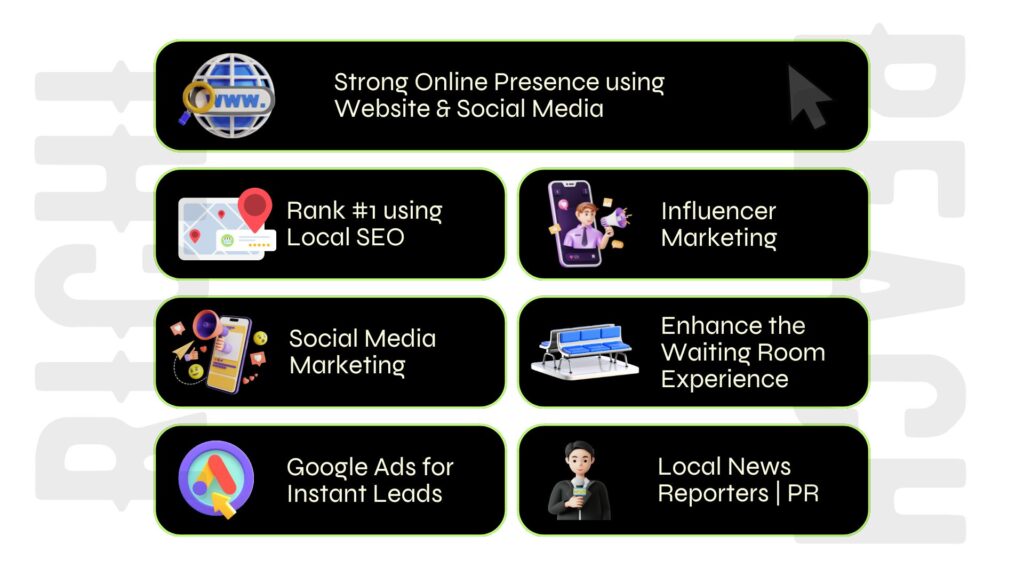Running a local clinic is both rewarding and challenging.
For healthcare providers, the goal is not only to deliver quality care but also to establish a trusted presence within the community.
However, attracting new patients, maintaining a strong reputation, and competing with larger healthcare facilities and online consultation platforms can be daunting.
In today’s landscape, the best digital marketing agency for healthcare has become an essential tool for healthcare providers to build credibility, expand reach, and connect with patients in meaningful ways.
By combining proven patient acquisition strategies with a well-rounded digital presence, doctors and clinic owners can overcome common hurdles and create a thriving practice.
In this blog, we’ll explore the challenges faced by local clinics and dive into how healthcare digital marketing and other strategic approaches can make a real difference.
41% of people said social media would affect their choice of a specific doctor, hospital, or medical facility.
6 Key Challenges Healthcare Providers Face in Running Clinics
Running a local clinic comes with its unique set of hurdles.
Let’s look at some of the most common issues clinics encounter:

1. Attracting New Clients
One of the toughest challenges for a local clinic is bringing in new clients. Most people tend to stick to what they know, and in healthcare, trust is everything.
So, getting new clients often requires more than just putting up a sign or posting on social media. It’s about showing potential clients they’ll get reliable care and personal attention—two things that set a local clinic apart from larger, more impersonal healthcare providers.
2. Reputation Management
In today’s world, a clinic’s reputation is largely shaped by online reviews and word-of-mouth. Just one or two negative reviews can make a big impact.
Managing your reputation isn’t just about damage control; it’s about actively encouraging happy patients to leave positive reviews.
This helps build trust and credibility, making it easier to attract new clients who feel confident in choosing your clinic.
3. Front Desk Inefficiencies
The front desk is often the first touchpoint for any patient, and it can make or break their experience. Long wait times, lost appointments, or a confusing check-in process can be frustrating and leave patients with a bad impression.
Streamlining front desk operations—whether that’s through training, better scheduling software, or clear communication—can make the whole experience smoother and encourage patients to return.
4. Limited Services
Sometimes, clinics are limited in the types of services they can offer due to budget, space, or even a lack of specialised staff. This can make it hard to compete with larger facilities or nearby clinics that offer a broader range of treatments.
Expanding your services strategically or partnering with other local providers can help bridge that gap and keep clients from going elsewhere.
5. Technology Advancement
Advances in healthcare technology, from electronic health records (EHRs) to digital imaging, have transformed how clinics can operate. However, investing in new technology can be expensive, especially for smaller clinics.
But even adopting a few digital tools, like online appointment booking or an EHR system, can improve patient experience, reduce errors, and make day-to-day operations more efficient.
6. Competing with Online Consultation Platforms
Finally, one of the biggest challenges facing local clinics is the rise of online consultation platforms. These platforms offer quick, convenient access to medical advice from the comfort of home, which can be especially appealing for busy clients.
However, local clinics can still compete by highlighting the value of in-person visits, such as hands-on care, a personal touch, and the ability to build long-term relationships with healthcare providers.
4 Common Ways Most Doctors in India Acquire Patients
In India, the approach to building a patient base is crucial for doctors to maintain a steady flow of clients and provide accessible care.
Here are four common strategies most doctors use to attract patients:

1. Clinic in a High-Foot-Traffic Area
Location is key to attracting patients, especially for doctors who rely on walk-ins. By setting up a clinic in a busy area, doctors can tap into the natural flow of people, increasing the chance of drawing new patients.
Areas near shopping centers, residential zones, or popular commercial spots provide excellent visibility and can serve as a continuous source of potential patients.
A clinic in a convenient, accessible location also creates a sense of trust, as it’s easier for people to reach and more visible within the community.
2. Traditional Marketing
While digital healthcare marketing in India has taken the forefront, traditional marketing still holds value.
Pamphlets distributed in neighbourhoods, advertisements in local newspapers, and features in regional magazines are ways to build awareness, especially among older populations who may not be as engaged online.
Traditional marketing also reaches those who prefer physical media, ensuring doctors reach diverse demographics within their community.
Digital marketing is often more effective than traditional methods because it allows you to track your ROI precisely. While it can be useful to experiment with traditional marketing, focusing on a full-time digital marketing approach is recommended for better insights, targeting, and measurable results.
3. Digital Marketing
Digital marketing has become essential in today’s world, with an increasing number of patients seeking health information and services online.
Social media ads, Google PPC, and having an informative, professional website all help build online visibility and credibility.
A strong digital presence can help doctors reach a larger audience, and it enables targeted advertising to connect with specific patient demographics.
We’ll dive deeper into digital healthcare marketing in india strategies in a dedicated section.
4. Referrals from Satisfied Patients and Other Doctors
Word-of-mouth referrals remain one of the most trusted ways for doctors to gain new patients.
A positive experience leads satisfied patients to recommend their doctor to friends and family. Additionally, doctors may refer patients to colleagues with specific expertise, creating a network of trust within the medical community.
Building strong patient relationships and maintaining good professional networks are therefore powerful drivers for sustained patient growth.
Digital Marketing for Hospitals: Building a Data-Driven and Strong Online Presence
In today’s digital landscape, hospitals can greatly benefit from a data-driven approach to patient acquisition and retention with the right healthcare marketing companies in India.
By establishing consistent branding and a strong online presence, hospitals can effectively connect with potential patients and build trust in their services.
Here are some powerful healthcare digital strategies to achieve this and drive measurable results:

1. Strong Online Presence by Website
Start with a professional and informative website that is easy to navigate and reflects your brand’s values. Ensure the site is mobile-friendly, secure, and optimized for a seamless user experience.
Your website is often the first impression patients have of your hospital, so it should highlight key services, staff credentials, patient testimonials, and contact information to encourage trust and engagement.
2. Local SEO
Local search engine optimization (SEO) is essential for hospitals looking to attract patients from nearby areas.
Optimizing your website and Google Business Profile with local keywords, accurate location details, and positive reviews will help your hospital appear in local search results.
This ensures that patients in your area can easily find you when they search for healthcare services.
3. Social Media Marketing
Social media platforms allow hospitals to engage with the community, share health tips, announce events, and promote services.
Consistently posting informative, engaging, and shareable content helps create a sense of connection with potential patients.
Platforms like Facebook, Instagram, and LinkedIn are especially useful for building brand visibility and nurturing relationships with followers.
One-third of consumers now use online sites like – facebook, Instagram, youtube and online forums for health-related matters.
4. Google Ads
Google Ads allow hospitals to appear at the top of search results for specific keywords. By targeting keywords like “hospital near me” or “specialty healthcare services,” you can attract highly relevant traffic to your site.
Paid ads give hospitals an advantage by reaching patients actively looking for healthcare services, leading to faster conversions.
5. Influencer Marketing
Partnering with local influencers in the health and wellness space can boost your hospital’s credibility and extend its reach. Influencers can share their personal experiences or educate their followers about the hospital’s services.
This strategy works especially well with local influencers who have a strong following in the community, as it helps hospitals connect with a wider audience in a relatable way.
6. Enhance the Waiting Room Experience
Digital marketing extends to the in-hospital experience as well. Creating an engaging waiting room experience.
Such as playing informative health videos, sharing positive patient testimonials on screens, or providing QR codes for online resources, enhances patients’ perceptions of the hospital. These small touches can make a big difference in brand perception and patient satisfaction.
7. Engage Local News Reporters
Collaborating with local news reporters can increase your hospital’s visibility and reputation within the community.
Sharing press releases, conducting interviews, and providing health-related insights to local news channels can boost credibility.
Positive media coverage not only builds trust with potential patients but also establishes your hospital as a trusted authority in healthcare.
By implementing these digital marketing strategies, hospitals can build a cohesive online presence, connect more effectively with the community, and drive better patient outcomes.
A combination of these approaches helps reinforce brand consistency and visibility, making it easier for patients to find and trust your hospital.
Conclusion
Running a local clinic in today’s competitive healthcare landscape requires more than just medical expertise; it calls for strategic positioning, consistent patient engagement, and effective reputation management.
With the right combination of traditional practices and modern digital marketing approaches, clinics can create meaningful connections within their communities, attract new patients, and foster a loyal clientele.
At RichiReach- a healthcare marketing agency India, we understand the unique challenges that healthcare providers face and are committed to helping clinics harness the power of digital solutions to grow sustainably and provide exceptional care.
Ready to elevate your clinic’s reach and enhance patient engagement?
Contact RichiReach to explore tailored healthcare digital marketing solutions designed specifically for healthcare providers.
Let us help you build a thriving practice that resonates with your community and keeps patients coming back. Reach out today to start making a real difference!

